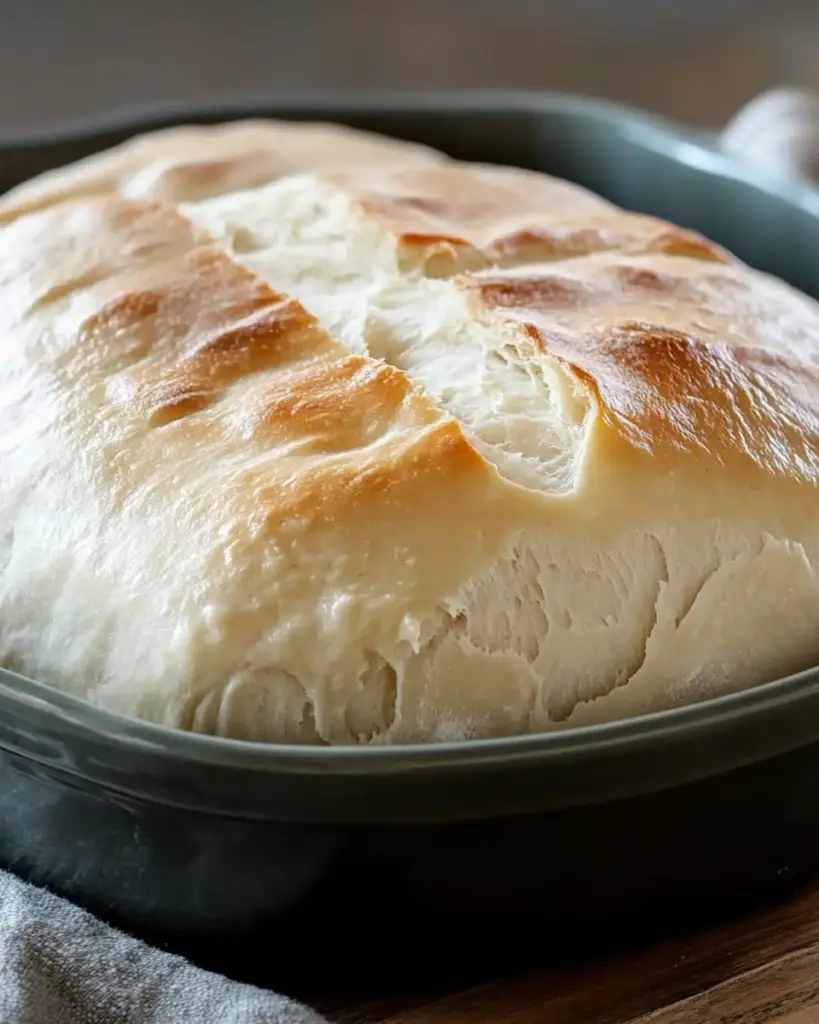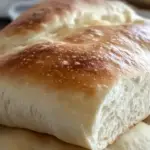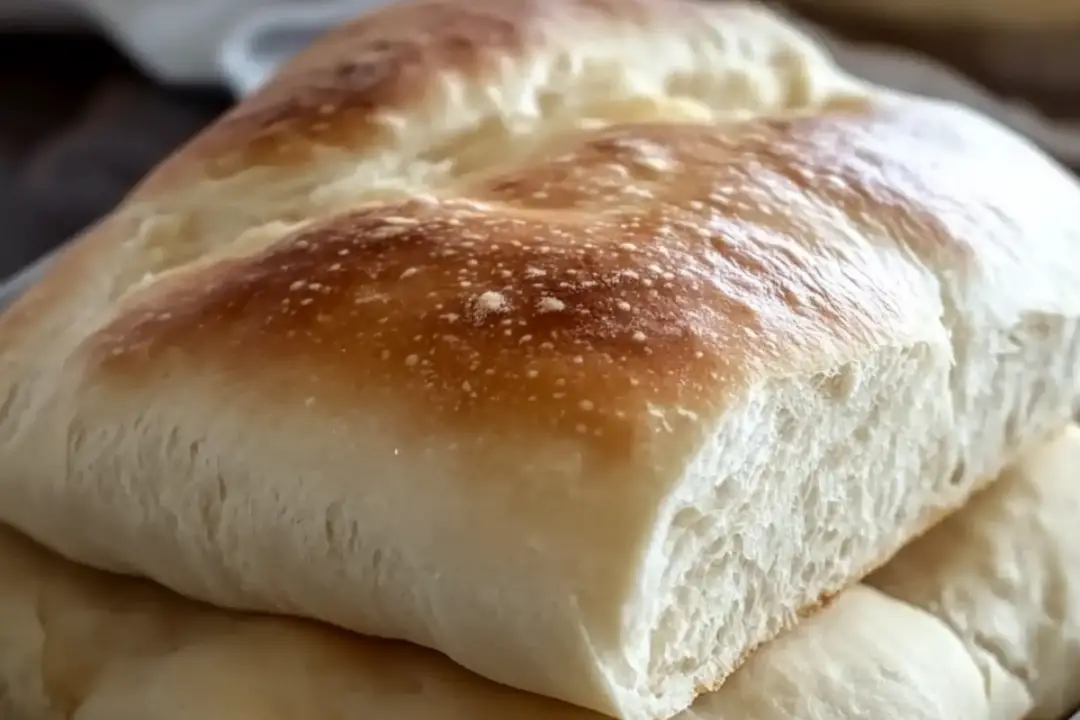Making your own bread dough at home is a special experience—there’s something so comforting about the smell of fresh bread baking in the oven, don’t you think? This Soft Homemade Bread Dough is the foundation for all kinds of baked goodies: from simple loaves to rolls and even pizza. It’s a warm, cozy feeling that’s almost like a hug in a loaf pan. Once you make this dough, you’ll wonder why you ever bought store-bought bread. Trust me, it’s that good. Plus, the best part? It’s easy to make, even for beginners!
This bread dough is soft, pliable, and incredibly versatile. It’s perfect for sandwiches, garlic bread, or just tearing into with a little butter. If you’ve ever wanted to try making homemade bread from scratch but weren’t sure where to start, this is the perfect recipe to give you that “I did it!” moment.
Why You’ll Love Soft Homemade Bread Dough
This dough is everything you want in a bread base: soft, fluffy, and simple to make.
Soft and Fluffy
It’s soft and light with just the right amount of chew. When you bake it up, you’ll have a bread that’s both fluffy and satisfying, but with that chewy texture we all love.
Versatile
The best part about this dough? It’s so versatile. You can make a loaf of classic bread, dinner rolls, or even pizza dough—there are endless possibilities for this simple dough recipe!
Budget-Friendly
Why spend money on store-bought bread when you can make it at home? This dough is made with simple, affordable ingredients that you probably already have in your pantry.
Easy to Make
No need to be intimidated by making homemade bread—this dough is beginner-friendly, with simple instructions that guide you every step of the way. Plus, you don’t need fancy equipment—just a mixing bowl, a spoon, and your hands!

Disclosure: This post contains affiliate links.If you click and make a purchase, I may earn a small commission at no extra cost to you.
Ingredients in Soft Homemade Bread Dough
Let’s take a look at the magic ingredients that make this dough so soft and delicious:
For the Dough:
- All-Purpose Flour: The main ingredient that gives this dough structure and chew.
- Active Dry Yeast: This is what makes the dough rise and gives it that airy, fluffy texture.
- Warm Water: Helps activate the yeast. Make sure it’s warm, not hot, or it could kill the yeast.
- Sugar: A little sweetness to help feed the yeast and create that light, fluffy dough.
- Salt: A necessary ingredient to balance the flavors and enhance the overall taste of the bread.
- Butter: Adds richness and flavor to the dough, making it soft and tender.
- Milk: Adds moisture and tenderness to the dough, giving it a slight creaminess.
(Note: The full ingredients list, including measurements, is provided in the recipe card directly below.)
Instructions
Ready to make this soft, fluffy bread dough? Let’s get started!
Step 1: Activate the Yeast
In a small bowl, combine the warm water, sugar, and active dry yeast. Stir gently, then let it sit for about 5-10 minutes, or until it becomes frothy. This step is key to making sure the yeast is active and ready to help the dough rise.
Step 2: Mix the Dough
In a large mixing bowl, combine the flour and salt. Once your yeast mixture is ready, pour it into the flour mixture, followed by the milk and melted butter. Stir everything together until the dough starts to come together into a ball.
Step 3: Knead the Dough
Turn the dough onto a floured surface and knead for about 8-10 minutes, or until the dough is smooth and elastic. It should be slightly tacky but not too sticky. If it feels too sticky, add a little more flour as needed.
Step 4: Let the Dough Rise
Place the dough in a lightly greased bowl, cover it with a clean towel, and let it rise for 1-1.5 hours, or until it has doubled in size. This is when the yeast works its magic, creating that soft, fluffy texture.
Step 5: Punch Down and Shape
Once the dough has risen, punch it down to release the air bubbles. Then, turn it out onto a floured surface and shape it into a loaf, rolls, or any other shape you like.
Step 6: Second Rise
Let the shaped dough rise for another 30-45 minutes, or until it has puffed up again. If you’re making rolls, make sure they’re evenly spaced on the baking sheet so they can expand during this second rise.
Step 7: Bake and Enjoy
Preheat your oven to 350°F (175°C). Once the dough has risen, bake it for 25-30 minutes (for a loaf), or until the top is golden brown and the bread sounds hollow when tapped. For rolls, bake for 15-20 minutes. Let the bread cool slightly before slicing—though, let’s be real, you’ll probably want to tear off a piece while it’s still warm. Enjoy!
Nutrition Facts
Servings: 10 (for a loaf) Calories per serving: 160
Total Fat: 4g
Saturated Fat: 2g
Trans Fat: 0g
Cholesterol: 10mg
Sodium: 200mg
Total Carbohydrate: 28g
Dietary Fiber: 1g
Sugars: 3g
Protein: 4g
Vitamin A: 4%
Vitamin C: 0%
Calcium: 15mg
Iron: 1mg
Potassium: 70mg
Preparation Time
- Prep Time: 15 minutes
- Rising Time: 1.5 hours (1 hour for the first rise, 30-45 minutes for the second rise)
- Cook Time: 25-30 minutes (for a loaf)
- Total Time: 2 hours
How to Serve Soft Homemade Bread Dough
Fresh Out of the Oven
There’s nothing like enjoying a warm slice of freshly baked bread straight from the oven, especially when it’s still a little bit soft in the center. You can slather it with butter, jam, or just enjoy it on its own.
As Sandwiches
Use this soft homemade bread to make sandwiches with your favorite fillings—cheese, deli meats, veggies, or even a little bit of turkey and cranberry sauce for a mini Thanksgiving-style sandwich.
For Dipping
This bread is perfect for dipping into soups, stews, or even a rich olive oil and balsamic vinegar blend. Its soft texture soaks up those dips so well!
For Toast
Slice the bread and toast it for a simple but delicious breakfast. Top with butter, peanut butter, or avocado for a satisfying morning treat.
Additional Tips
Use the Dough for Rolls
Instead of baking a loaf, you can easily shape the dough into rolls. Simply divide the dough into small portions and roll them into balls before letting them rise a second time. Bake them for 15-20 minutes, or until golden brown!
Don’t Over-knead
While kneading is an important step, be careful not to overdo it. Knead just until the dough is smooth and elastic. Over-kneading can result in denser bread.
Freezing Dough
This dough freezes beautifully! After the first rise, punch it down and shape it into a loaf or rolls. Wrap it tightly in plastic wrap and freeze for up to 3 months. When you’re ready to bake, let it thaw in the fridge overnight, then proceed with the second rise and baking instructions.
Add Flavor Variations
Want to get a little creative? Try adding garlic powder, herbs like rosemary or thyme, or even a sprinkle of cheese to the dough for extra flavor.
FAQ Section
Q1: Can I use whole wheat flour instead of all-purpose flour?
A1: Yes! Whole wheat flour will make the bread a bit denser and heartier. If you’re using whole wheat flour, you may need to add a little more water to achieve the right dough consistency.
Q2: Can I make this dough without butter?
A2: Yes, you can substitute the butter with olive oil or vegetable oil for a slightly different flavor and texture.
Q3: Can I use instant yeast instead of active dry yeast?
A3: Absolutely! If using instant yeast, you don’t need to activate it in warm water—just mix it directly with the flour and proceed with the rest of the recipe.
Q4: How do I store homemade bread?
A4: Store the bread in an airtight container or wrapped in plastic to keep it fresh for 2-3 days. If you want to keep it longer, freeze slices for later use.
Q5: Can I use this dough for pizza?
A5: Yes! This dough works wonderfully as pizza dough. Simply roll it out into your desired shape, top with sauce and cheese, and bake until golden brown and bubbly.
Q6: How do I know when the bread is done baking?
A6: The bread is done when the top is golden brown, and it sounds hollow when you tap it gently on the bottom.
Q7: Can I make the dough ahead of time?
A7: Yes, you can make the dough and refrigerate it after the first rise. When you’re ready to bake, just let it come to room temperature before shaping and proceeding with the second rise.
Q8: Can I double the recipe?
A8: Definitely! Just make sure you have a large enough bowl for the dough to rise. You might need to extend the rising time slightly for larger batches.
Q9: How can I make this dough sweeter for sweeter breads or rolls?
A9: Simply add a bit more sugar to the dough for a sweeter flavor. You can also mix in cinnamon or vanilla for extra sweetness in rolls.
Q10: Can I freeze the dough before baking?
A10: Yes! Freeze the dough after the first rise and shape it into a loaf or rolls. When you’re ready, let it thaw in the fridge overnight, then let it rise again before baking.
Conclusion
There’s nothing quite like the satisfaction of pulling a loaf of homemade bread out of the oven, and this Soft Homemade Bread Dough is the perfect way to start your baking journey. With its soft, fluffy texture, it’s incredibly versatile—perfect for everything from simple loaves to rolls and pizza. Plus, making it at home is so much easier than you might think! Whether you’re baking for yourself or for a crowd, this dough will always bring a little warmth and joy to the table. Happy baking!
Print
Soft Homemade Bread Dough
- Total Time: 0 hours
- Yield: 1 loaf or 12 rolls
Description
This soft homemade bread dough is perfect for making a variety of breads, from loaves to rolls. With a simple, easy-to-follow process, it creates a dough that is soft, light, and perfectly textured for a fluffy, golden-brown finish. Ideal for beginners and seasoned bakers alike, this dough can be customized to suit any bread recipe you desire.
Ingredients
- 2 1/4 tsp active dry yeast (1 packet)
- 1 tbsp sugar
- 1 1/4 cups warm water (110°F or 45°C)
- 3 1/2 cups all-purpose flour (more for dusting)
- 1 tsp salt
- 2 tbsp olive oil (or vegetable oil)
- 1 tbsp butter (optional, for softening the dough)
Instructions
-
Activate the Yeast:
In a small bowl, combine the warm water and sugar. Sprinkle the yeast over the top of the water and stir gently. Let it sit for 5-10 minutes, until the mixture becomes frothy and bubbly. This indicates the yeast is activated. -
Mix the Dough:
In a large mixing bowl, combine the flour and salt. Make a well in the center and pour in the yeast mixture, along with the olive oil. Stir the mixture with a spoon until it begins to come together into a dough. -
Knead the Dough:
Transfer the dough onto a lightly floured surface and knead for 8-10 minutes until it becomes smooth, elastic, and slightly tacky to the touch. You can add a little more flour if the dough feels too sticky, but be careful not to add too much, as this can make the bread dense. -
Let It Rise:
Grease a clean bowl with a little oil or butter. Place the dough in the bowl, turning it around to coat it with the oil. Cover the bowl with a damp towel or plastic wrap and let it rise in a warm place for 1-1.5 hours, or until it has doubled in size. -
Shape the Dough:
Once the dough has risen, punch it down gently to release the air bubbles. Turn the dough out onto a floured surface and shape it into a loaf or divide it into portions for rolls, buns, or other shapes. -
Second Rise:
Place the shaped dough on a baking sheet or into a loaf pan. Cover it again and let it rise for 30-45 minutes, or until it has puffed up and is slightly raised. -
Bake the Bread:
Preheat your oven to 375°F (190°C). Bake the dough for 25-30 minutes (for rolls) or 30-35 minutes (for a loaf), or until the bread is golden brown on top and sounds hollow when tapped on the bottom. -
Cool and Serve:
Allow the bread to cool on a wire rack before slicing. Enjoy your soft, homemade bread!
Notes
- If you want a richer flavor, you can add 1 tablespoon of honey or a bit of milk instead of water.
- The dough can be refrigerated for up to 24 hours during the first rise. If you’re planning to do this, be sure to allow the dough to come to room temperature before shaping it.
- For a crispier crust, place a small pan of water in the oven while the bread is baking to create steam.
- You can brush the top of the dough with melted butter once it’s baked for a soft, shiny finish.
- Prep Time: 10 minutes
- Cook Time: 25-30 minutes
- Category: Bread
- Method: Baking
- Cuisine: American
Nutrition
- Serving Size: 1 slice (from a loaf)
- Calories: 120
- Sugar: 2g
- Sodium: 150mg
- Fat: 3g
- Saturated Fat: 0.5g
- Unsaturated Fat: 2.5g
- Trans Fat: 0g
- Carbohydrates: 21g
- Fiber: 1g
- Protein: 3g
- Cholesterol: 5mg




